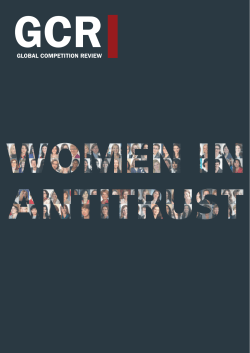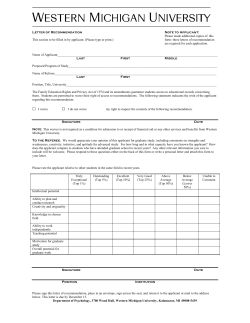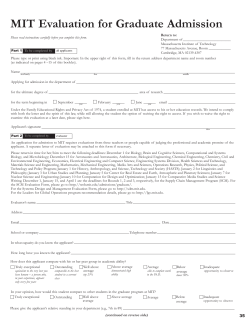
DOJ Antitrust Division’s Revised Leniency Program Further
January 2009 DOJ Antitrust Division’s Revised Leniency Program Further Restricts Corporate Options in Responding to Cartel Allegations BY KIRBY BEHRE, E. LAWRENCE BARCELLA, JR., JEREMY EVANS AND ADAM SCHWARTZ In direct response to the Department of Justice Antitrust Division’s loss in the controversial Stolt-Nielsen criminal antitrust case, the Antitrust Division revised its leniency policy. The Division has prepared revised Model Leniency Letters and issued an explanatory document entitled Frequently Asked Questions Regarding the Antitrust Division’s Leniency Program (the “FAQ”).1 Most notably, the revisions require leniency program applicants to contractually agree that they will not seek pre-indictment judicial review of Antitrust Division decisions to revoke conditional leniency agreements. While Scott Hammond, the Deputy Assistant Attorney General for Criminal Enforcement, recently described this revision in a recent article as “simply reflect[ing] well established caselaw,”2 it is difficult to view it as anything other than an attempt to forestall the difficulties encountered by the Division in Stolt-Nielsen. The Stolt-Nielsen Decisions In Stolt-Nielsen, the Antitrust Division revoked its leniency agreement with the shipping company, alleging that Stolt-Nielson had not taken prompt and effective action to terminate anticompetitive conduct upon discovery, as required by the agreement. The company sued the Government pre-indictment to enforce the conditional leniency agreement, but lost in the Third Circuit on separation of powers grounds. Stolt-Nielsen, S.A. v. U.S., 442 F.3d 177 (3rd Cir. 2006). Following indictment, Stolt-Nielsen again sought to enforce the leniency agreement and to dismiss the Indictment. The U.S. District Court for the Eastern District of Pennsylvania held an extensive evidentiary hearing, and found that the company took prompt and effective action pursuant to the agreement, did not participate in the alleged conspiracy once the company discovered the anticompetitive conduct, and cooperated fully with the Antitrust Division. Id. The Court held that non-prosecution agreements are binding contracts and that Stolt-Nielsen did not breach its obligations under the contract. U.S. v. Stolt-Nielsen S.A., 524 F.Supp.2d 609 (E.D. Pa. 2007). The Indictment was dismissed. The Antitrust Division Response to Stolt-Nielsen Under the new policy, a leniency applicant must waive its right to judicial review of any DOJ effort to revoke its agreement before the Antitrust Division indicts the Company. While the stated purpose of the new policy is to increase transparency and predictability in the leniency program, the paramount concern in revising the policy appears to be to thwart judicial review of future leniency agreements and prevent companies from launching a preemptive judicial challenge should DOJ Antitrust revoke a leniency 1 agreement. The new FAQ and revised letters state that “the Antitrust Division’s Leniency Program is an exercise of the Division’s prosecutorial discretion, and [the leniency applicant] agrees that [it/he/she] may not, and will not, seek judicial review of any Division decision to revoke [its/his/her] conditional leniency unless and until [it/he/she] has been charged by indictment or information for engaging in the anticompetitive activity being reported.”3 The Antitrust Division receives confidential, sometimes privileged, and usually incriminating information during the cooperation process from leniency applicants. Under the new revocation policy, the Antitrust Division can revoke its leniency agreements without challenge and then use the information voluntarily provided by the company to secure an indictment against that company.4 A post-indictment challenge to enforce the agreement may do little to repair the damage caused by the use or release of confidential information in the indictment. Additional Changes to the Policy The FAQ also include additional information on the leniency application process and clarification regarding the leniency “marker” process; the handling of non-antitrust crimes in connection with an antitrust leniency application; and the treatment of a leniency applicant and its employees involved in another Antitrust Division investigation. The FAQ state that the Deputy Assistant Attorney General for Criminal Enforcement has the ultimate authority to review and approve all requests for leniency, although applicants may initiate a request with any of the Antitrust Division’s seven field offices or its National Criminal Enforcement Section based in Washington, D.C. The FAQ also provide guidance on the leniency “marker” process. The first applicant can secure a “marker,” to obtain leniency should it perfect its application. To obtain a marker, counsel is required to fulfill four preliminary obligations to the Antitrust Division: (1) report that information or evidence indicates that a criminal antitrust violation may exist; (2) disclose the general nature of conduct discovered; (3) identify the industry, product, or service involved in terms specific enough to allow the Antitrust Division to determine whether leniency is available and to protect the marker for the applicant; and (4) identify the client. The FAQ note that a company seeking leniency must perfect its application within a short period of time or risk losing its “first-in” advantage. The Antitrust Division will commonly offer a 30 day period for an initial marker and retain discretion to extend for an additional finite period. Clearly, however, a leniency applicant is expected to conduct a prompt and thorough investigation to determine the full extent of the antitrust conduct and then disclose it to the Antitrust Division. Failure to do so presents a risk that the company will lose the “marker,” thereby allowing another applicant to secure leniency ahead of it. The FAQ also discuss the treatment of nonantitrust crimes in connection with an antitrust leniency application. As an example, the FAQ consider an applicant seeking leniency for participating in a bid-rigging conspiracy that involved the bribery of a foreign public official in violation of the Foreign Corrupt Practices Act (“FCPA”). Where the antitrust and non-antitrust violations are directly related, the Antitrust Division will not prosecute the leniency applicant for either the bid-rigging conspiracy or the FCPA violation. If, however, the FCPA violation is unrelated to the antitrust violation, then the leniency letter will not prevent the prosecution of the company for the FCPA offense. In either instance, the leniency letter provides no protection against any other Federal entity prosecuting the applicant for the non-antitrust violation. The only recourse proposed for the applicant is to enter into a separate agreement with the relevant prosecuting division or agency seeking protection from prosecution. 2 When the leniency applicant is a subject, target, or defendant in a separate antitrust investigation, the Antitrust Division will include a separate paragraph in the conditional leniency letter stating that any protection from prosecution extends only to the activity reported in the leniency application and not to the separate investigation. DOJ retains the right to prosecute the company or individuals in connection with the separate investigation. Model Leniency Letters In addition to the new FAQ, the Antitrust Division released revised model corporate and individual leniency letters. Each includes sections in which the applicant agrees that it is eligible to receive leniency because of “prompt and effective action” to terminate participation in the anticompetitive action upon discovery. The applicant must also acknowledge that it did not coerce another party to participate in the anticompetitive activity and was not the leader or originator of the anticompetitive conduct. Applicants must agree to cooperate fully with the leniency letter’s requirements that the applicant provide documents and make employees available for interview. The revised letter includes a paragraph setting forth the grounds under which the Antitrust Division can terminate the leniency application and, as noted, bars the applicant from challenging that decision until the applicant is charged by Indictment. In the case of corporate applications, the letter provides for non-prosecution protection for corporate directors, officers, and employees, providing that they agree to produce documents in the United States and make themselves available for interviews there. Conclusion Corporations considering participation in the Antitrust Division’s leniency program must be cognizant of the substantial concessions they must make in return for leniency. An applicant that elects to apply for leniency commits to an irrevocable path whereby it must volunteer incriminating information. Should the Antitrust Division revoke its conditional grant of leniency, that information may be used in a future indictment and in any prosecution of the applicant, making the defense of that case difficult if not practically impossible. Although the leniency program still may present an attractive option for corporations facing severe penalties for noncompliance with antitrust statutes, the new FAQ and Model Leniency Letters demonstrate that the Antitrust Division has designed the program to provide the greatest advantage and discretion to the Government. Cooperation will be rewarded, but on terms defined and dictated by the Antitrust Division. 3 If you have any questions concerning these developing issues, please do not hesitate to contact any of the following Paul Hastings lawyers: Washington, D.C. Kirby Behre 202-551-1719 kirbybehre@paulhastings.com Jeremy Evans 202-551-1755 jeremyevans@paulhastings.com E. Lawrence Barcella, Jr. 202-551-1718 larrybarcella@paulhastings.com Adam Schwartz 202-551-1799 adamschwartz@paulhastings.com 1 These documents are available on the Department’s website at http://www.usdoj.gov/atr/public/criminal/leniency.htm. 2 Scott D. Hammond, Division Issues Frequently Asked Questions Regarding Leniency Program, Cartel and Criminal Practice Committee, December 2008. 3 Available at http://www.usdoj.gov/atr/public/criminal/leniency.htm. 4 See Model Corporate Leniency Letter, available at http://www.usdoj.gov/atr/public/criminal/239524.htm; Model Individual Leniency Letter, available at http://www.usdoj.gov/atr/public/criminal/239526.htm. 18 Offices Worldwide Paul, Hastings, Janofsky & Walker LLP www.paulhastings.com StayCurrent is published solely for the interests of friends and clients of Paul, Hastings, Janofsky & Walker LLP and should in no way be relied upon or construed as legal advice. The views expressed in this publication reflect those of the authors and not necessarily the views of Paul Hastings. For specific information on recent developments or particular factual situations, the opinion of legal counsel should be sought. These materials may be considered ATTORNEY ADVERTISING in some jurisdictions. Paul Hastings is a limited liability partnership. Copyright © 2009 Paul, Hastings, Janofsky & Walker LLP. IRS Circular 230 Disclosure: As required by U.S. Treasury Regulations governing tax practice, you are hereby advised that any written tax advice contained herein or attached was not written or intended to be used (and cannot be used) by any taxpayer for the purpose of avoiding penalties that may be imposed under the U.S. Internal Revenue Code. 4
© Copyright 2025
![[Name and address] Dear [Name]:](http://cdn1.abcdocz.com/store/data/000033280_2-8ba4d2b96350948b62884ad0245e8c64-250x500.png)
















